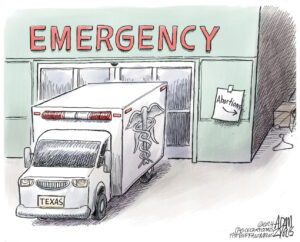Amid Abortion Debate, the Pursuit of Science
The federal government won't fund research into abortion care, including aspects of safety, even though one-third of women will have the procedure.
By Nina Martin, ProPublicaThis piece originally appeared at ProPublica.
For the last decade or so, Tracy Weitz has been one of the most prominent abortion researchers in the United States.
As director of the University of California at San Francisco’s Advancing New Standards in Reproductive Health (ANSIRH), part of the Bixby Center for Global Reproductive Health, she has co-authored seven studies in major journals in the past year alone, on topics ranging from how low-income women pay for abortions to why some women who want an abortion delay until it is too late.
This summer, one of the studies she oversaw persuaded California lawmakers to allow trained non-doctors (nurse practitioners, certified midwives, physician assistants) to perform first-trimester abortions, possibly the biggest expansion of abortion access since the Food and Drug Administration approved the abortion pill in 2000.
Now, just as some of ANSIRH’s most ground-breaking work is starting to see the light of day, Weitz is leaving the world of clinical research. She has taken a job at an organization she declined to name but where she hopes her impact on women’s reproductive health issues will be broader and deeper.
Weitz recently spoke with ProPublica’s Nina Martin. This conversation has been edited and amended for clarity and brevity.
* * *
NM: How did abortion become the main focus of your work? What is your background?
TW: I’m a medical sociologist by training. I started off trying to figure out how to deliver health care services. I did that for many years as an administrator and was frustrated that we seemed to just be rearranging the deck chairs on the Titanic. I also have a real interest in policy and politics. Abortion for me has always been the natural place in which all of those things come together. It is a political issue. It is a social issue. It is a health care issue. It is a feminist issue.
NM: What are some of the main challenges to doing abortion research in this country?
TW: The federal government has a prohibition on funding any research that involves abortion care. You cannot get funding from the National Institutes of Health to study, say, abortion techniques 2014 how to make it safer. But this ban has been interpreted very, very broadly to preclude funding anything involving abortion, even a topic like women’s emotional responses. That has left the funding of research on abortion to the philanthropic community.
Now, it’s very unusual for foundations to fund clinical research. It’s not historically what they do 2014 research is the domain of government. But in the last 10 years, there’s been recognition in the philanthropic community that in order to make progress [on reproductive rights], whether culturally or politically or in the service-delivery arena, there are research questions that we need to answer.
This [private funding] has opened up an enormous avenue for researchers who are interested in questions about abortion care, abortion policy, and abortion in American culture. But it comes with its own downside, which is that people are very suspect of research that is funded by organizations that have particular ideological agendas.
NM: As researchers, what kind of hurdles and antagonism do you face?
TW: There’s definitely a difference between the social scientists who do the research and the MDs who actually do abortions. Abortion doctors have had assassinations, barricades and constant protesters. As researchers, our safety hasn’t really been in question.
Most of the harassment comes at the level of trying to discount our academic reputation2014 suggesting that anyone who does abortion-related research who believes that abortion should be legal shouldn’t be trusted. That somehow our science is tainted, that we haven’t used good methods. That’s why we have a strong interest in being published in the peer-reviewed literature. We think that the science should be open to scrutiny. It should be put through the same kind of rigor that other clinical or social research is.
NM: Let’s talk about the study that has probably had the greatest impact so far: the one looking at whether trained non-doctors 2014 nurses, midwives, physicians assistants 2014 can safely perform vacuum-aspiration abortions in the first trimester. That study included nearly 20,000 patients throughout California 2014 one of the largest studies on abortion ever done in the United States. The study had two key findings. First, it found almost no difference in complication rates in abortions done by doctors versus non-doctors. Second, the overall rate of complications for both groups was very low 2014 much lower than abortion opponents claim. Has the study shed light on other abortion-related issues as well?
TW: Yes. One has to do with hospital transfers [patients who require hospital care after having an abortion]. We were interested in this topic, of course, because it’s a category of complication, and you want to track it. But it wasn’t something we intended to focus on.
Then states [including Texas] started passing new laws that require physicians who offer abortion care to have admitting privileges to hospitals. And we realized that, thanks to [the non-doctor] study, we had very good data showing that complications requiring transfers to hospitals are actually exceedingly rare.
Of about 20,000 patients over several years, only four were directly transferred.
NW: There’s a second study I want to talk about, which is known as the Turnaway Study. It’s a long-term study looking at what happens when women who want an abortion can’t get one. They show up at a clinic too late and are turned away.
TW: First some background. At the Bixby Center and ANSIRH, we are driven by three sets of issues and concerns. One is: How can care be best delivered? That’s the question underlying the non-physician study. We’re very interested in safety in general. Do you need to be in an ambulatory surgery center? Do you need to have a nurse who administers anesthesia? Which kinds of cervical preparations are safe and do the least damage to the cervix?
Two, we care a lot about women’s experiences. We know that 1 in 3 women are going to have an abortion in their lifetime. And choosing to be a parent or not is a big decision. Whatever a woman decides, we want to know what can improve their outcomes. What do they need from their social networks and their friends? What are the long-term effects of silence and secrecy?
The third area of interest is social inequities. Where is there uneven distribution of services, uneven distribution of economic outcomes?
The Turnaway Study arose out of the second and third set of concerns. Abortion opponents have been pushing the idea that abortion hurts women, that they feel regret. With 1.3 million women having an abortion every year, it’s likely that a certain number do feel regret. That’s the natural curve of any kind of big decision. What we want to know is: Who are those women and what do they need?
But another of our questions was: what happens to women who wanted an abortion but couldn’t get one? What happens to her economically, what happens to her psychologically, what happens to her other kids? That was the underlying question behind the Turnaway Study.
NM: Can you summarize the findings so far?
TW: The take-home from that study is that most women are having an abortion because they say they can’t afford to have a child. And it turns out that they’re right: Two years later, women who had a baby they weren’t expecting to have, compared to the women who had the abortion they wanted, are three times more likely to be living in poverty. They knew they couldn’t afford a kid and it turns out they were correct.
NM: Can you give some specifics about how the study was designed?
TW: The principal investigator is Diana Greene Foster, who was trained as a demographer. It is an eight-year study and includes about 30 abortion facilities in every region of the country. The sole criteria was that the clinic had to be isolated 2014 it had to be the only one within 150 miles that was willing to do abortions up to whatever it set as its gestational limit [the latest point at which it will terminate a pregnancy]. So if a woman was turned away from that facility, she really had no other option. She probably was going to have that baby.
We recruited about 1,000 women 2014 that alone took us three years. About a quarter were women who had been turned away and had a baby they weren’t expecting. Approximately 500 were women who happened to be just under the gestational limit when they arrived at the clinic so were able to get the abortion they wanted. They were the comparison group.
We also wanted to know if women receiving earlier abortions were somehow different. So the remaining participants 2014 about 250 2014 are women who received first-trimester abortions.
We followed the women every six months for five years 2014 a phone interview with a very lengthy survey that includes every question we could think of about their mental health, their economic circumstances, using routine and standardized tools, so we have some basis for comparison. Everyone in the study has finished at least two years, and some women have completed their five years and are rolling off.
NM: What has been your most eye-opening finding?
TW: The study has really exposed how hard it is to be a parent in this country. It is a huge economic investment. And if you don’t have the economic resources to be a parent, there’s nothing to help you.
Data from the study is also helping to answer other questions for which we have no good research until now 2014 for example, how women feel about mandatory ultrasounds before an abortion and what factors contribute to some women feeling regret afterwards.
NM: Finally, I want to talk about some preliminary research you presented at a conference last fall, looking at how state and federal courts view the kind of research you are working on.
TW: ANSIRH was started specifically to ensure that health policy is grounded in evidence. Because many laws aimed at restricting abortion were ending up in the courts, I became interested in how judges were interpreting the science in their legal decisions. We focused on four abortion-related issues where the science is pretty clear 2014 whether women are at risk for suicide after abortion, gestational bans based on the presumption that the fetus feels pain, ultrasound-viewing mandates, and medical abortion regimens.
We looked through over a thousand documents 2014 including lawsuits, briefs, rulings by courts at every level, the scientific studies that are referenced, the CVs of the medical experts whose work was cited. We analyzed not just the court decisions, but their language about the scientific claims, how expert knowledge is referenced, the quality of the research, whether the studies appeared in peer-reviewed journals 2014 that kind of thing. We’ve really just scratched the surface 2014 we had no idea how much there would be out there.
NM: What have you found?
TW: There is no consistent standard for how science is or is not incorporated into the legal decisions. Across the decisions, the same scientific studies are adjudicated very differently. Overwhelmingly what we do see is political ideology substituted for objective standards in adjudicating scientific claims. We were very disheartened to find that many of the judicial decisions were discounting the science altogether. I think I was a little naive. I had this idea that the courts were more objective.
Since I started this work, I’ve been intrigued to discover that there’s a whole body of criticism 2014a lot of it around climate change 2014 over whether courts should have anything to do with science. When the D.C. federal court was set up, all the patent cases went there. There was a recognition that these issues were really complicated 2014more science-y 2014 and you needed to have judges who had specific expertise to decide them. Now, whether they’re about environmental science or, in our case, health-related science, these cases are being spread out across multiple courts, and judges with absolutely no scientific training are being asked to make adjudications about science. Should we be training judges to review science? Should we be thinking about specialty courts with scientific expertise?
One of the more troubling findings is the way that controversy has become a reason to discount science. There’s a great book called “Merchants of Doubt” [Naomi Oreskes and Erik Conway, Bloomsbury, 2011]. It’s about the production of scientific controversy as a way to discount legitimate scientific research and clear-cut consensus about tobacco or climate change, but it also applies to abortion. As the book points out, you don’t need to disprove science anymore. All you need to do is suggest that the science is actually in doubt. Courts will then look at and say, “It’s a controversy, so deference should go to the Legislature,” or “It’s a controversy, so we’ll do whatever we want.”
A contributing problem is that, in the legal context, medical experts and scientists who do abortion or study abortion have been seen as suspect. Lisa Harris, at the University of Michigan, has written some great stuff on what she calls “The Legitimacy Paradox.” It goes like this: By virtue of doing an abortion, you’re not a real doctor. Therefore, real doctors don’t do abortions. Therefore, you have the right to regulate them because they’re not real doctors.
NM: That brings me to the last thing I want to talk about, which is the issue of stigmatization. That’s a major thread in your research and writings. Why is this issue is so important to you?
TW: A stigma is a mark that makes you seen as morally suspect.It’s not just bad. It’s bigger than bad.
In the abortion context, stigmatization means that your position on abortion says everything about you as a human being. To do abortion means that you are morally corrupt. The fact that you would have an abortion means you’re a different kind of person. And the consequences associated with disclosure 2014 whether it’s “I support legal abortion,” “I do abortions,” “I’ve had an abortion” 2014 now carry huge social weight. That leads to silence.
Now, I’m a person who fundamentally believes in doing anything that I can to help women have their families when they want to have their families. If I can help her figure out how she gets the contraception she wants and she picks the partners she wants and she has the money she wants so that she never has to have an abortion, then I’ve been a success.
But if she needs an abortion, she needs an abortion. And I’m there for her with that support. I’ve never met a woman who said, “It’s on my bucket list to have an abortion.”
I want everyone to have every tool in their tool-box to be able to have a family, when and if they want to. Any of those strategies are legitimate strategies. That includes abortion.
Correction: This post originally stated that the FDA approved the morning-after pill in 2000. The abortion pill was approved in 2000.
Your support matters…Independent journalism is under threat and overshadowed by heavily funded mainstream media.
You can help level the playing field. Become a member.
Your tax-deductible contribution keeps us digging beneath the headlines to give you thought-provoking, investigative reporting and analysis that unearths what's really happening- without compromise.
Give today to support our courageous, independent journalists.






You need to be a supporter to comment.
There are currently no responses to this article.
Be the first to respond.